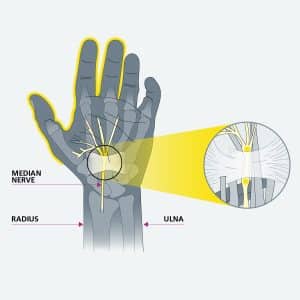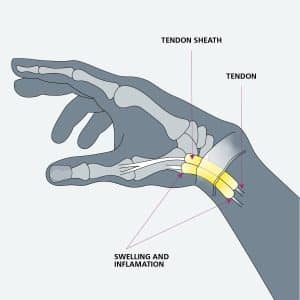As well as pelvic girdle pain and back pain there are other relatively common conditions that cause pain or discomfort during pregnancy.
Usually, with simple advice and education, symptoms can be well managed and kept under control.
However, if your symptoms are persisting or affecting your ability to carry out day-to-day activities then do seek advice from a health care professional or consider a referral to the Pelvic Health Physiotherapy Service.

Carpal Tunnel Syndrome
The carpal tunnel is an inelastic structure located in the wrist. Tendons, nerves and blood vessels all pass through this structure to supply the hand. A nerve called the median nerve sits within this tunnel. The median nerve is responsible for giving you feeling in your thumb and fingers and making the tendons work properly.
In pregnancy, hormonal changes can cause swelling to many parts of the body such as your wrist and hands. The extra swelling puts pressure on the median nerve inside the carpal tunnel. This can cause symptoms in your hands such as pins and needles, numbness and pain known as carpal tunnel syndrome.
Carpal tunnel syndrome is most likely to occur from 5 or 6 months pregnant.
Carpal tunnel syndrome can often be treated at home and usually improves after your pregnancy ends. If symptoms are worsening, not going away or are not improving with at-home treatment then you should seek a review with a health care professional.
You may experience one or more of the following symptoms:
- Pins and needles and/or numbness in your thumb, fingers, hand or wrist
- Pain in your thumb, fingers, hand or wrist
- Symptoms may be worse at night or first thing in the morning
- Weakness in the hand, thumb and fingers
- You may experience trouble performing dextrous tasks such as writing or doing up buttons
- You many drop things due to altered strength in your hand
Self-management for carpal tunnel:
- Elevate your wrist and hands with pillows or cushions if you are sitting or lying down. This can help reduce swelling in the carpal tunnel
- Try to keep your wrist in a neutral position when carrying out day to day activities such as typing, lifting or writing
- Try to avoid repetitive activities where you are likely to bend your wrist or grip hard for long periods of time
- Apply ice cubes wrapped in a damp tea towel to your wrist for 10-15minutes, 3-4 times a day. Do not apply ice if you cannot tell the difference between hot and cold. Check the skin every few minutes to ensure you are not causing any ice burns.
- Try to limit or pace activities that you know make your symptoms feel worse
- A wrist splint is something that can be worn to help keep your wrist straight, relieving pressure on the nerves in the wrist. Splints can often be worn at night or in the daytime during activities where symptoms are made worse.
You should ensure to have regular breaks without the splint on during the day for hand hygiene and to ensure that your wrist movement does not become stiff.
Splints can be purchased online or at local pharmacies. If you would like further guidance about the use of splints, then contact your GP or the Pelvic Health Physiotherapy Service.
- Gentle hand exercises may help relieve symptoms associated with Carpel Tunnel Syndrome. A Physiotherapist will be able to guide you.

De Quervain’s Tenosynovitis
De Quervain’s is an irritation of the tendons or tendon sheath on the thumb side of your wrist.
The Abductor Pollicis Longus (APL) and Extensor Pollicis Brevis (EPB) tendons pass through a compartment located in the wrist which can become inflamed and narrow, making it more difficult for the tendons to move normally.
In pregnancy, hormonal changes can cause swelling to many parts of the body such as your wrist and hands. Swelling can put additional pressure on the tendons within this compartment leading to symptoms associated with De Quervain’s.
You may experience one or more of the following symptoms:
- Pain in the thumb, wrist and/or forearm
- Tenderness over the tendon sheath
- Swelling around thumb side of wrist
- Clicking, creaking or grinding sound or sensation of the thumb tendons
Symptoms of De Quervain’s can commonly arise after childbirth. This is often due to repetitive movements of the hand a wrist such as lifting and carrying which are often required when looking after a new-born.
Self-management for De Quervain’s:
- Try to limit or avoid activities or tasks which make your symptoms feel worse
- Avoid repetitive thumb movements where possible
- Modify or change the way in which you lift or carry items and objects to reduce strain on the thumb tendons
- Apply ice cubes wrapped in a damp tea towel to your wrist for 10-15 minutes, 3-4 times a day. Do not apply ice if you cannot tell the difference between hot and cold. Check the skin every few minutes to ensure you are not causing any ice burns.
- A thumb and wrist splint is something can be worn to help keep your wrist and thumb still, relieving pressure on the tendons in the wrist. Splints can often be worn in the daytime during activities where symptoms are made worse.
You should ensure to have regular breaks without the splint on during the day for hand hygiene and to ensure that your wrist movement does not become stiff.
Splints can be purchased online or local pharmacies. If you would like further guidance from about the use of splints, then contact your GP or the Pelvic Health Physiotherapy Service.
- Gentle hand exercises may help relieve symptoms associated with De Quervain’s. A Physiotherapist will be able to guide you.
Rib Pain
Rib pain is common in pregnancy, especially in the last trimester.
There may be several different causes for your rib pain.
Causes may include:
- Pregnancy hormones relax your ligaments and may be a factor
- Stretching and adjusting as baby grows
- Your breasts are also growing, and the extra weight can pull your shoulders forwards and down putting a strain onto your back, neck and ribcage.
- As baby grows bigger you may also find yourself out of breath as it is harder to breathe deeply. You may get referred pain into your shoulders from nerves in your diaphragm.
- Pressure on your stomach may cause acid reflux/ indigestion. This can also give rib pain symptoms.
Rib pain symptoms usually will improve after your pregnancy ends.
Self help management for rib pain:
- Take breaks from activities and change your position regularly
- Stand tall with your shoulders back and head up.
- When you are sitting try not to slump down. Put a small cushion or support behind your lower back.
- Wear a well fitted bra which gives good support, preferably without an underwire which can dig in your ribs.
- Heat treatment. Warmth can reduce aches and pains. Hot water bottles and wheat packs wrapped in a protective towel and placed over your ribs may help. Apply for 10-15 minutes, 2-3 times a day. Never apply heat directly over your bump or if you are unable to tell the difference between hot and cold. Ensure you check your skin every few minutes to check for skin burns.
- Gentle exercises may help alleviate rib pain symptoms. Download the booklet below for more information.
Things to look out for:
Although rib pain is common in pregnancy and not usually serious, there are some things you should look out for. See your doctor if you experience any of the following:
- Pain that comes on after eating food, especially fatty food, which radiates between your shoulder blades, and you also have a fever and vomiting along with the pain.
Pregnancy puts women at a higher risk of gallbladder disease.
- Pain on the right side of your rib area that is sudden and acute, accompanied by dizziness, “floaters” or spots in your vision, headaches, and nausea/vomiting. Pregnancy puts women at risk of a serious condition known as pre-eclampsia.
- Pain that is sudden and acute, and which appears after a long bout of coughing. It is possible you may have an antenatal cough-induced rib fracture.
Remember that the above conditions are rare, and most pregnancy-related rib pain is common and not serious. If symptoms are worsening, not going away or are not improving with at-home treatment then you should seek a review with a health care professional.
Rib pain during pregnancy leaflet Back to pregnancy and after childbirth